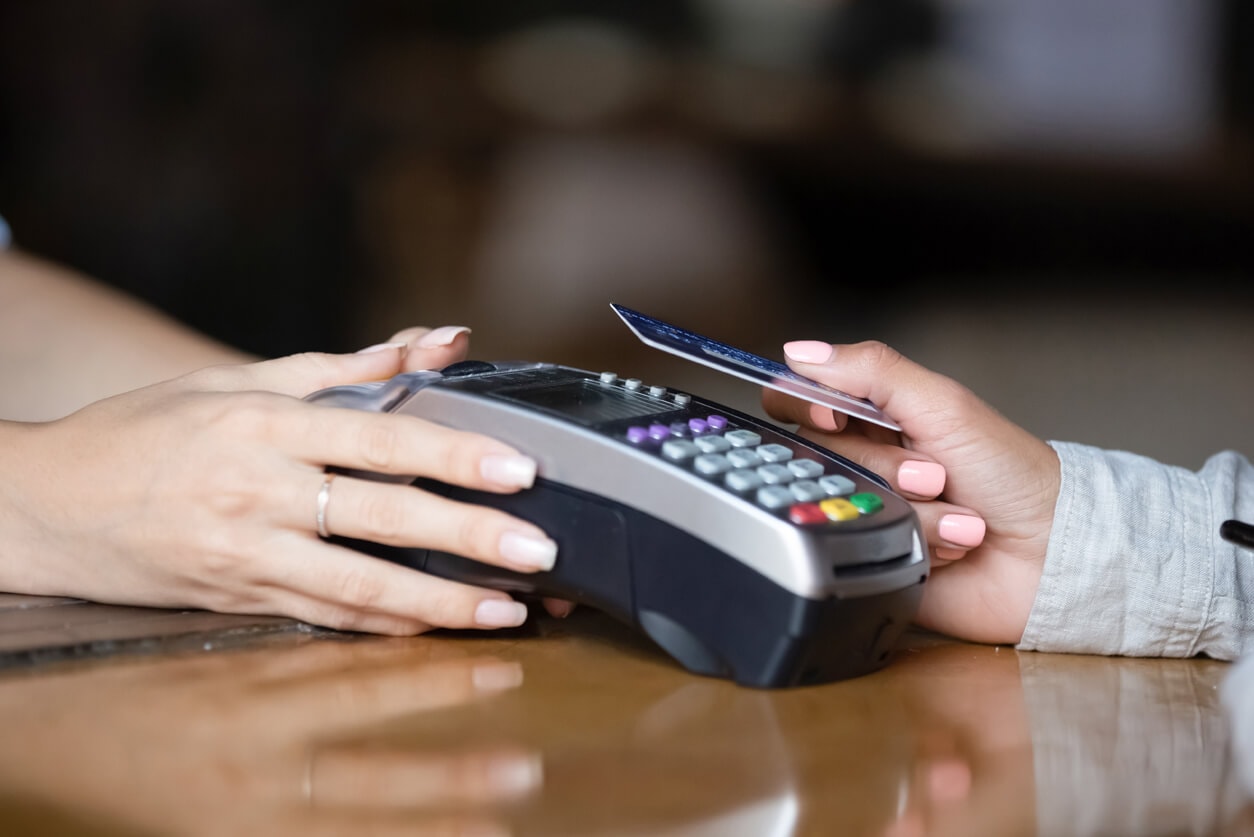What Is a Contactless Credit Card and How Does It Work?
4 Min Read | Last updated: March 31, 2025

This article contains general information and is not intended to provide information that is specific to American Express products and services. Similar products and services offered by different companies will have different features and you should always read about product details before acquiring any financial product.
Learn how contactless credit cards work. See how you can use them for quick and secure transactions and discover why they are a popular payment method.
At-A-Glance
- Contactless credit cards, digital wallets, and contactless-enabled devices speed up and streamline the checkout process.
- Contactless payment options are considered highly secure.
- Contactless payments are on the rise in the U.S., with shoppers viewing touch-free options as cleaner alternatives to cash and traditional chip cards.
It’s not your imagination: Everyone from the java fans lining up for cappuccinos at your favorite coffee shop to families ordering burgers at the local fast-food hangout have been using contactless credit cards, smartphones equipped with digital wallets, and contactless capable devices like tablets, smartwatches, and key fobs, to tap-and-pay – and go on their way.
Contactless credit cards have caught on because they’re:
- Fast — Quicker than other ways of paying in-store.
- Convenient — They streamline the checkout process.
- Safe — Contactless technology offers additional security features.
- Touch-free — They provide a cleaner alternative to cash and card readers at payment terminals.
For all these reasons, more people are using contactless payments and a growing number of retailers are accepting them.
Here’s a closer look at how they work.
How to Use a Contactless Credit Card or Digital Wallet
Contactless cards are easy to identify. The front of the credit card shows a small contactless logo resembling a radio wave or a sideways Wi-Fi symbol. The same logo may be visible on retailers’ contactless-capable payment readers.

When you’re ready to pay, simply wave or tap the contactless credit card or digital wallet, positioning it close to the contactless icon on the merchant’s payment reader. In a few seconds, you’ll hear a beep, or see a checkmark or green icon on your mobile device, indicating that your transaction is complete.
How Contactless Payment Technology Works
Contactless credit cards are equipped with tap-to-pay technology, meaning they have an EMV chip like most modern credit cards plus a contactless chip.1 So, they’re able to transmit encrypted data with a contactless-enabled reader at the time of purchase. Digital wallets come in devices like smartphones, wearables, and laptops, and are armed with the same near-field-communication (NFC) technology.2
Contactless cards may still work if a store doesn’t have contactless capability. You can just dip your card into the card reader and use it as a standard EMV-chip card.
Why Contactless Payments Are Considered Highly Secure
When it comes to credit card security, contactless credit cards offer additional security features compared to their magnetic strip counterparts, partly because they’re encrypted. Contactless credit cards, digital wallets, and contactless-enabled digital devices send an encrypted one-time-only code — or “token” — to the retailer’s reader. That token does not include private information like your name and credit card number. The use of these tokens is why you may have heard the word “tokenization” in connection with contactless payment technology.3
The need for the credit card or mobile device to be close to the reader further curtails the potential for bad actors to intercept the payment exchange. In addition, the next time you use your card it will transmit a totally different code — so any intercepted data would be unique to each transaction.
Digital wallets have additional safety precautions. The physical credit card can remain tucked away while you wave your smartphone. Plus, you can protect your digital wallet by setting a strong passcode and enabling multifactor authentication.4
The Future of Contactless Payments
Experts believe that contactless transactions will continue to grow as widespread adaption increases. According to a study from Juniper Research, the value of contactless payment transactions is projected to reach $15.7 trillion globally by 2029, up from $7.4 trillion in 2024. Underlying contactless payments ecosystem, including soft point-of-sale terminals at small businesses and device-level support are key driver of contactless transactions value growth.5
The Takeaway
Contactless credit cards and digital wallets are growing in popularity. Tap-to-pay technology makes touchless transactions fast, and they’re highly secure thanks to encryption and tokenization. As more retailers install contactless-enabled readers, contactless payments are expected to continue growing.
1 “EMV® Contactless Chip
2 “EMV® Mobile
3 “EMV® Payment Tokenisation
4 “Are Digital Wallets Safe?
5 “Contactless Payment Transactions to Hit $15.7 Trillion Globally by 2029
SHARE
Related Articles
Is Contactless Payment a Wiser Choice?
Discover the surge in contactless payments, offering convenience and security through tap-to-pay technology and mobile wallets for faster and safer transactions.
How to Get an Instant Approval Credit Card—and Use it Instantly!
It takes 3 steps to get and use an instant approval credit card – which is different from credit card pre-approval. Learn how to apply for one online.
What Is a Digital Wallet?
Digital wallets offer convenience, allowing you to make purchases using your phone. This article explores the benefits of digital wallets and how they work.
The material made available for you on this website, Credit Intel, is for informational purposes only and intended for U.S. residents and is not intended to provide legal, tax or financial advice. If you have questions, please consult your own professional legal, tax and financial advisors.










